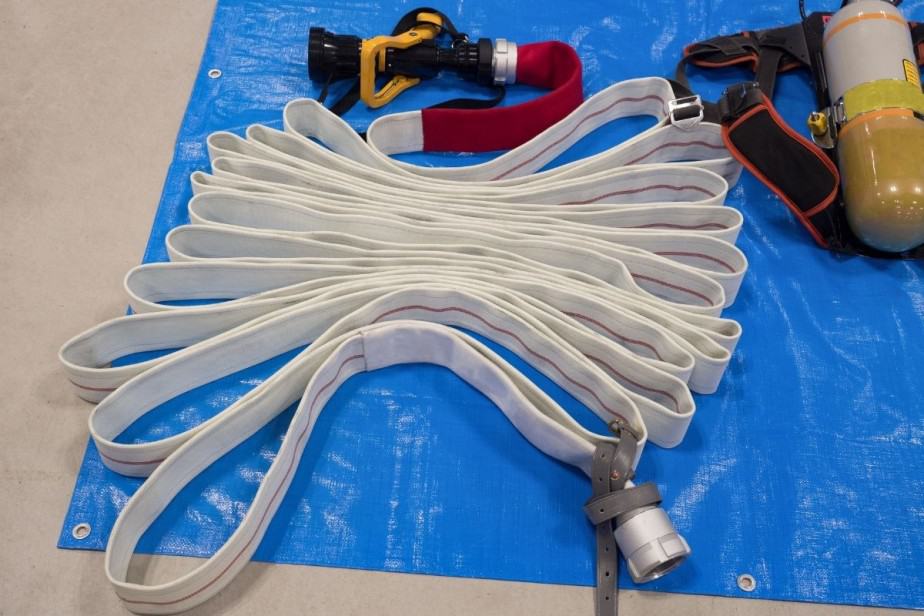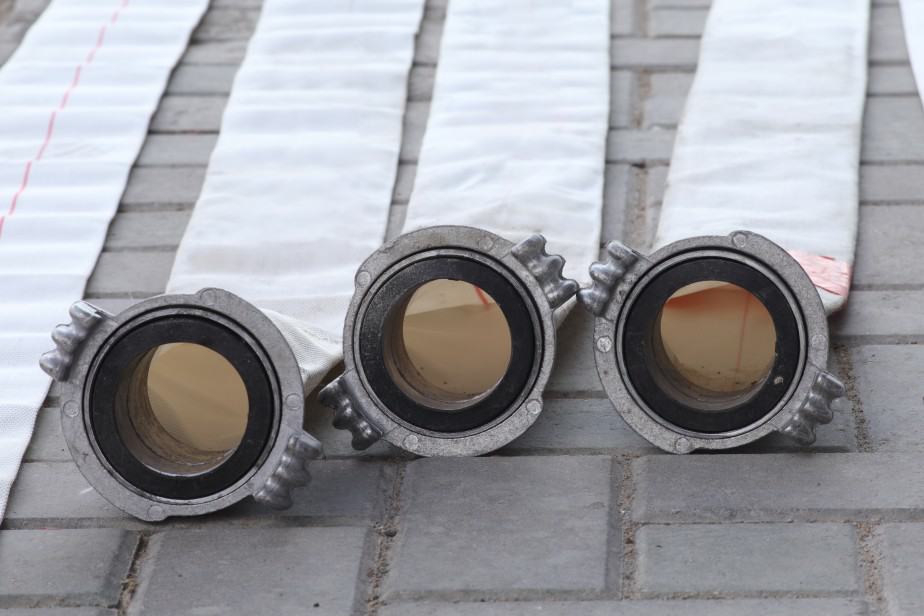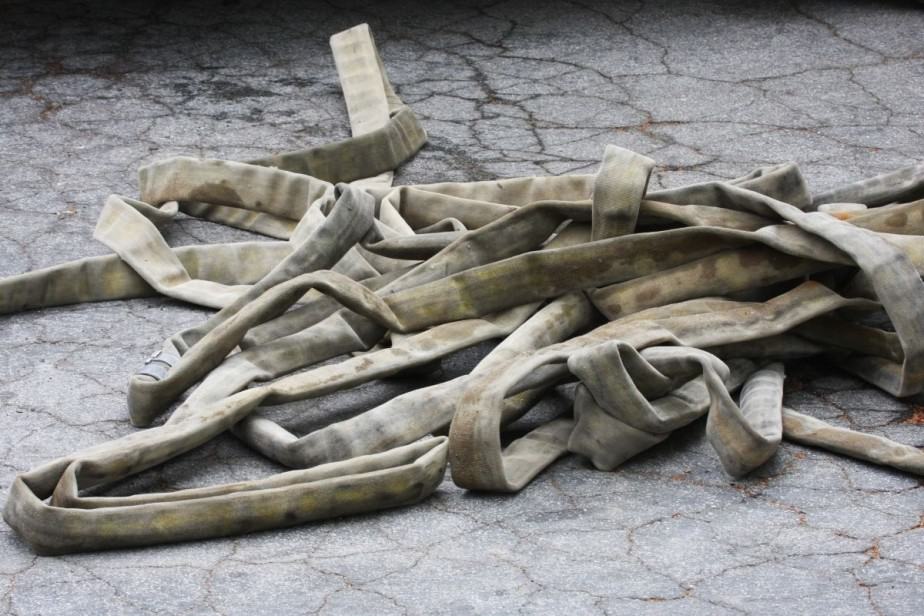If you’ve ever seen firefighters at work (although hopefully not on your own property), then you’ve noticed how skilled they are at maneuvering a fire hose. If you’re thinking of someday becoming a firefighter yourself, you know handling a hose will be a requirement of the job. That makes you curious, how much does a fire hose weigh?
The weight of a fire hose varies depending on its size, but all are pretty heavy. A 1 ¾-inch fire hose is approximately 20 pounds per 50 feet (dry). A 50-foot section of 2.5-inch fire hose when full might weigh 129 pounds and a 5-inch diameter fire hose weighs approximately 55 pounds per 50 feet dry (110 pounds per 100 feet dry) and more than 900 pounds when full!
In this guide, we’ll talk further about how much fire hoses weigh depending on their diameter. We’ll also discuss the weight of a water-filled hose versus an empty one, so make sure you keep reading!
Table of Contents
Fire Hose Weights Per Size
Not all fire hoses are the same, which is one of the first things you’ll need to know if you want to become a firefighter. Hoses are categorized by their diameter, which is the measurement around the base of the hose itself. Let’s start with a simple chart to give you an overview, then we’ll go into more detail.
| Hose Diameter | Weight (empty) | Weight (full) |
| 1.5 inch | 17 lbs (per 50 feet) 34 lbs (per 100 feet) | 55 lbs (per 50 feet) (~4.5 gal) 110 lbs (per 100 feet) (~9 gal) |
| 1 ¾ inch | 20 lbs (per 50 feet) 40 lbs (per 100 feet) | 70 lbs (per 50 feet) (~6 gal) 90 lbs (per 100 feet) (~13 gal) |
| 2 inch | 23 lbs (per 50 feet) 46 lbs (per 100 feet) | 91 lbs (per 50 feet) (~8 gal) 182 lbs (per 100 feet) (~16 gal) |
| 2.5 inch | 27 lbs (per 50 feet) 54 lbs (per 100 feet) | 129 lbs (per 50 feet) (~13 gal) 258 lbs (per 100 feet) (~26 gal) |
| 4 inch | 40 lbs (per 50 feet) 80 lbs (per 100 feet) | 312 lbs (per 50 feet) (~33 gal) 624 (per 100 feet) (~66 gal) |
| 5 inch | 55 lbs (per 50 feet) 110 lbs (per 100 feet) | 463 lbs (per 50 feet) (~51 gal) 926 lbs (per 100 feet) (~102 gal) |
| 6 inch | 68 lbs (per 50 feet) 136 (per 100 feet) | 680 lbs (per 50 feet) (~73 gal) 1360 (per 100 feet) (~146 gal) |
Fire hoses with a diameter of 1.5 to 3 inches are considered “attack lines.” Attack lines are the hoses that are typically used to spray water on the fire. These hoses are known for their flexibility and their lightweight fabric covering.
Most attack hoses are available in 50-foot lengths and can hold pressures up to and around 400 pounds per square inch of pressure or PSI and sometimes more. They are commonly stored on fire trucks in some form of a Mattydale lay, more commonly known as a cross lay.
Hoses with a diameter over 3.5 inches are known as “supply lines.” These hoses are used to supply water to the truck, run through a pump, and forced out through the attack lines. These hoses have a larger diameter of up to 5 inches. They too are flexible (but only moderately) and usually covered in fabric, but their max water pressure is lower, 200 to 300 PSI.
Knowing that, let’s examine the weight of the most common attack and supply hoses now.
1 ¾-Inch Fire Hose Weight
One of the narrowest and most common diameter attack lines is 1 ¾ inches. While it depends on the materials used to make the hose, the average weight of a hose of this diameter is 0.34 pounds per foot (or about 20 pounds per 50 feet of length).
“Inch and three-quarter” attack lines are best used for smaller fires. Most fire engines have at least one 1 ¾ attack line available for use on the truck. For example, at my department we have two, 200-foot sections of 1 ¾ attack lines used as pre-connects (these are attack lines already connected to the truck and ready to flow water). We also have a 150-foot length of 1 ¾ ready to use stored in the front bumper of the engine.

To make sense of that number, we have to do some math. As we mentioned earlier in this section, most attack lines come in 50-foot sections. Using that average length, by multiplying 0.34 and 50, you get 17 pounds (we’ll play it safe and assume 20 pounds due to different materials depending on the manufacturer). We’re assuming the hose is empty at this weight.
If that’s the case, then this is among one of the lightest attack lines you will come across.
2 ½-Inch Fire Hose Weight
If you add another 3/4 inch in diameter to the 1 ¾ attack line, you have a 2 ½-inch fire hose. Assuming the hose is full of water, at that diameter, a 50 foot section weighs approximately 129 pounds. When dry, you’d lessen the weight of these attack hoses considerably.
When the day comes that you pull a “two and a half” off of a truck to flow water you will feel a significant difference. Two and a half is typically used for larger fires where you need to put a lot of water on a fire. Think of instances like commercial/industrial fires, large garage fires, or the type of fires where you just sit in the front yard and spray water because the structure is a total loss.
While not all fire engines use a two and a half as a pre-connect (every department is different), all fire engines have two and a half in the hose bed. Two and a half is also used as a backup supply line.
5-Inch Fire Hose Weight
Now we’re moving past attack lines territory and getting into supply lines with larger diameters; also known as “LDH” or “LDL” large diameter hose/line. There’s only one bigger supply line diameter you’ll see besides 5 inches, and that’s 6 inches, and they are not that common.

Since supply hoses are longer, we’ll use 100 feet of hose as our standard measurement instead of 50 feet. If you had 100 feet of 5-inch diameter supply hose, it would weigh 110 pounds empty. Filling it with water would increase the weight to 926 pounds.
I should also mention that “five inch” as it is commonly called also comes in 50 and 25 foot sections. The reason for this is if you pull up right next to a fire hydrant it would be a huge pain to pull 100 feet of supply line only to connect to a hydrant 15 feet away.
Empty vs. Full Fire Hose: What’s the Weight Difference?
Reading that last section has you curious: is a fire hose that’s full of water really that much heavier compared to an empty one? Yes, actually. The weight difference can be huge!
Assuming the environment is room temperature, which is defined as being 72 degrees Fahrenheit, one gallon of water weighs approximately 8.33 pounds. By storing water at higher or lower temperatures, it could become denser. That would make it heavier as a result.
However, for the sake of simplicity, we’ll just assume that a gallon of water is kept in a room temperature environment and maintains its weight of 8.33 pounds.
Two gallons of water weigh 16.66 pounds, three gallons are 24.99 pounds, four gallons are 33.32 pounds, and five gallons of water weigh 41.64 pounds. Pretty heavy, right? Yet, it gets heavier.
Six gallons of water weigh 49.97 pounds, seven gallons would be 58.30 pounds, eight gallons of water weigh 66.63 pounds, and nine gallons weigh 74.96 pounds. If you had 10 gallons of water, the weight you’re carrying is 83.29 pounds.
Water pumps through a firefighter’s hose, but that water is stored on the fire truck. The average size of a fire truck is 35 feet, so these are sizable vehicles that can carry a lot of water. The standard amount of water available on a fire truck is 500 gallons.
So, since we know that one gallon of water is 8.33 pounds, 500 gallons would weigh 4,165 pounds. Now, the fire hose doesn’t receive the full amount of water available on the fire truck unless for severe fires, and certainly not all at once.
Even still, knowing that a 5-inch fire hose weighs over 900 pounds when full (per every 100 feet of hose) and it’s about 100 pounds when empty, the difference in weight is somewhere in the ballpark of 800 pounds!
The Factors That Influence Fire Hose Weight
To provide further clarity, let’s talk about some factors that can make two fire hoses of similar sizes weigh more or less than the other.
Diameter
This is a huge factor. The wider the diameter, the bigger the fire hose. A large hose uses more materials and thus will always be heavier than a hose with a smaller diameter. You only need to compare a 5-inch hose to one with a diameter of 1 ¾ inches to see an example of that.
Also, as I’m sure you can imagine, the larger the diameter the more water that can be held in the hose at a given time.
Water Volume
We just covered this in the last section, but it bears repeating. Adding water to a fire hose increases its weight by about 8 pounds per gallon. The heaviest hoses are 5-inch full hoses, but even a 50-foot section of 1 ¾ attack line can hold a surprising amount of water.
Material
Although all modern fire hoses tend to be made of nylon, polyester, or another synthetic fabric, key differences in the material can drive the hose’s weight up (or even down). For instance, supply lines, while flexible, don’t need as high of a degree of flexibility as an attack line.
Supply lines have a more rigid construction that prevents collapse. This construction will include a rubber liner, fabric layers, and an outer reinforcement layer made of rubber, wire mesh, or plastic. The latter material is used to make supply hoses more flexible.
Further, during the production of fire hoses, polymer reinforcers or additives are utilized, which can produce a softer or harder hose. Supply hoses, as mentioned, are harder and attack hoses are considered softer. The inclusion of polymer reinforcement can increase the weight of the hose even further.
Single vs. Double Jacket
How many layers between the outer covering of the fire hose and its liner also plays a role in the weight of a fire hose. Some hoses have a single jacket. As the name implies, there’s only one fabric layer added to this hose. You’re more likely to see this with attack lines so they can maintain their flexibility.
A double jacket adds more fabric and stiffness to the hose, boosting its weight.
Tips for Maintaining Fire Hoses
If you’re hired as a firefighter, I promise you will be tasked with cleaning and rolling hose, and a lot of it. Although you’ll want to get it done as soon as possible don’t cut corners and properly clean and store the hose.
Since the hoses belong to the fire department, keeping them in good condition is to everyone’s benefit. Here are some tips for maintaining your fire hoses.
Lubricate the Appropriate Parts
At least annually, maybe even twice per year if yours is frequently used, apply lubricant on the coupling, the raceway, the locks, and the lug of the fire hose. Don’t just rub on any old lubricant you have lying around at the fire station, but dry silicone lubricant.
This product can withstand cold and hot temperatures so the lube won’t wear away the first time you actively use the fire hose again. Further, dry silicone lube prevents sand or dirt from sticking to it.
Don’t worry about lubricating the seals and gaskets , but be sure to check them regularly.
Let the Outer Jacket Dry Before Reloading
Although you’ll be tempted to repack the hose as soon as you can. If the outer jacket is still soaking, which will probably happen after every fire, and you pack it away this can create mold.

Depending on the color of the outer jacket, you might not notice that mold has grown on your fire hose until you begin smelling it or–even worse–feeling it. Repacking the fire hose after it is completely dry can keep mold away.
If a hose is affected by mold, it’s a good idea to let your supervisor know so they can clean it out or discontinue using that fire hose.
Decontaminate After Hazardous Materials Exposure
While almost all fires conatin hazardous materials, you will eventually fight fires that will expose you to an unusual amount of hazardous materials, especially flammable solids or liquids. Other contaminants include dry ice, corrosives, aerosols, and some battery-powered equipment.
If your fire hose comes out of the blaze soaked or covered in hazardous material, then decontaminating it should be among the first things you do when you get back to the firehouse (after you decon yourself, of course). You certainly don’t want to use that fire hose again until all traces of hazardous waste are removed.
The only exception is if the hose was exposed to nitrile rubber aka nitrile butadiene rubber. In that case, wiping it away is the best course of action since nitrile resists chemicals, fuel, and oil.
Clean the Fire Hose Carefully
Even if your day of firefighting didn’t expose you to hazardous materials, you still need to clean the hose regularly. The guidance for doing such is outlined in the NFPA 1962: Standards for the Care, Use, Inspection, Service Testing, and Replacement of Fire Hose, Couplings, Nozzles, and Fire Hose Appliances.
Specifically, you’ll find the information you’re looking for in Chapter 4: Care, Use, Inspection, Service Testing, and Replacement of Fire Hoses, Section 4.6, Cleaning and Drying.
Don’t Drag the Fire Hose
Outside of fire ground operations, dragging the hose should be avoided as much as possible. By dragging the hose, especially near folds or edges, you create friction on the outer jacket. Dragging also causes premature wear and tear.
Fire hoses can be quite heavy, with some weighing 100 pounds when empty and over 900 pounds when full! Considering that water is more than 8 pounds per gallon, this makes sense. We hope this article helped you better appreciate the grueling work that firefighters do. If you’re trying to become a firefighter yourself, this information is a must-know!
People Also Ask:
How often should fire hoses be replaced?
Fire hose should be replaced every 10 to 20 years depending on several factors. Routine cleaning, maintenance and texting of your fire hose will extend the life of the hose. NFPA 1962 has regulations specifically addressing the maintenance, inspection and servicing of fire hoses.
What size hose do firefighters use?
The three most common fire hose sizes are 1 ¾ inch, 2.5 inch, and 5 inch. Both the 1 ¾ inch and 2.5 inch are used primarily as attack lines, while the 5 inch is considered large diameter hose and used as a supply line.